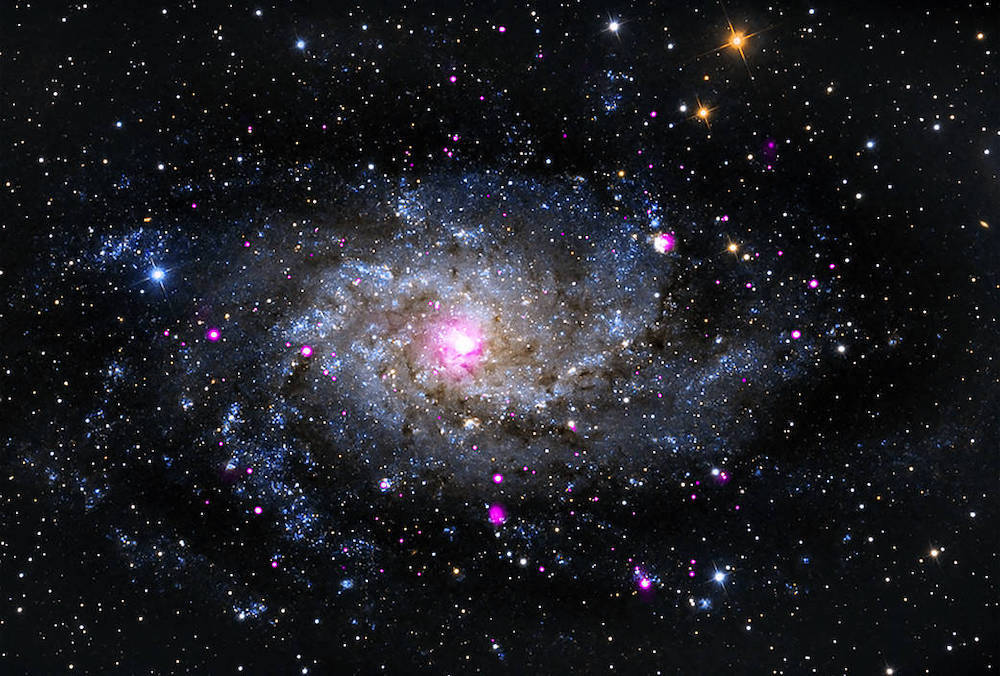Create a free profile to get unlimited access to exclusive videos, sweepstakes, and more!
Galaxy that appeared out of nowhere might finally solve a cosmic mystery
When an amateur scientist found a new dwarf galaxy, it opened up possible answers for a cosmic mystery.

How can something as enormous as a galaxy (even a relatively small one) seem to just materialize in space? Something that is too far and too faint can manage to hide for eons.
This is what can happen if you geek out hard on space. When an amateur scientist scoured publicly available data and discovered a new dwarf galaxy, astrophysicists were beyond thrilled. Either of the two things it might be will be groundbreaking. If it is an isolated galaxy, that could possibly mean it is the faintest lone galaxy ever. It could also be a satellite galaxy orbiting the Triangulum galaxy, or M33, which could prove theories of galactic formation right.
Giuseppe Donatiello was just really into space like the rest of us, but what he found lurking in a universe of data sparked David Martínez-Delgado and his team of astrophysicists to look closer. They analyzed images taken with the Telescopio Nazionale Galileo, which went into some more depth about this mysterious galaxy, and then processed the data further to confirm what they were seeing really was a dwarf galaxy. It is now known as Pisces VII or Tri III (depending on what more advanced telescopes can reveal about it). If it’s really Tri III, this could be huge.
“Simulations predict that massive galaxies like our Milky Way were formed from the accretion of a few hundreds of low-mass systems composed of gas, dark matter, and stars,” Martínez-Delgado told SYFY WIRE. “Survivors and debris from this process should be detectable, but the current census of satellites shows fewer visible satellites than expected.”
Martínez-Delgado's findings were recently published in Monthly Notices of the Royal Astronomical Society. The Large Magellanic Cloud similar in size to Pisces VII, is is a satellite itself — it orbits the Milky Way. It is still massive enough to have seven satellites. The advantage this cloud of stars has over Pisces VII is that it is much closer to Earth and therefore easier to observe in detail. There is only one other possible satellite for M33. Galaxies are usually expected to have smaller galaxies floating around them, but M33 challenged this. If Pisces VII can be proven to be another M33 satellite, and more show up, that could better illuminate how galaxies are born.
Similarly to how the Large Magellanic Cloud orbits the Milky Way, M33 orbits the even more gargantuan Andromeda galaxy. It is also Andromeda’s most massive satellite. More mass means more gravity, so it should have been able to hold on to at least a handful of satellites itself. This is why astronomers and astrophysicists expected M33 to have minions. Its distance from Earth may have been limiting what is observable, making any hypothetical satellites too faint for most telescopes. The Keck Observatory might be able to tell Martínez-Delgado more.
“Because these stars are very faint, this requires a giant telescope like Keck. Giant telescopes like that and Gemini North, which we will be observing from soon, can detect fainter stars due to their higher resolution,” he said. “The best method to derive the distance to these low-mass satellites is the color magnitude or the detection of certain stars.”
M33 had been thought to lack satellite galaxies because of how it evolved. It could be that an unpleasant encounter with Andromeda warped it about 2 billion years ago. If this happened, Andromeda, otherwise known as M31, would have ripped off M33’s halo of stars and any satellite galaxies it might have had. Never mind what happened in the past. Recent simulations of how both galaxies moved during this interaction suggest that while some material from M33 must have been consumed by M31, it should still have more than one satellite.
“For measuring how Pisces VII moves and if it is orbiting M33, it is necessary to measure both galaxies’ radial velocity using spectra from several resolved red giant stars. To confirm whether it is an isolated or satellite galaxy, we need a more accurate distance measurement,” Martínez-Delgado said.
Because Pisces VII is already faint, that might mean any other satellites which might be out there with it — if it really is Andromeda’s satellite — have not yet been seen because their light is not strong enough to reach Earth from 2.7 million light years away. If they exist, they won’t hide forever.


























